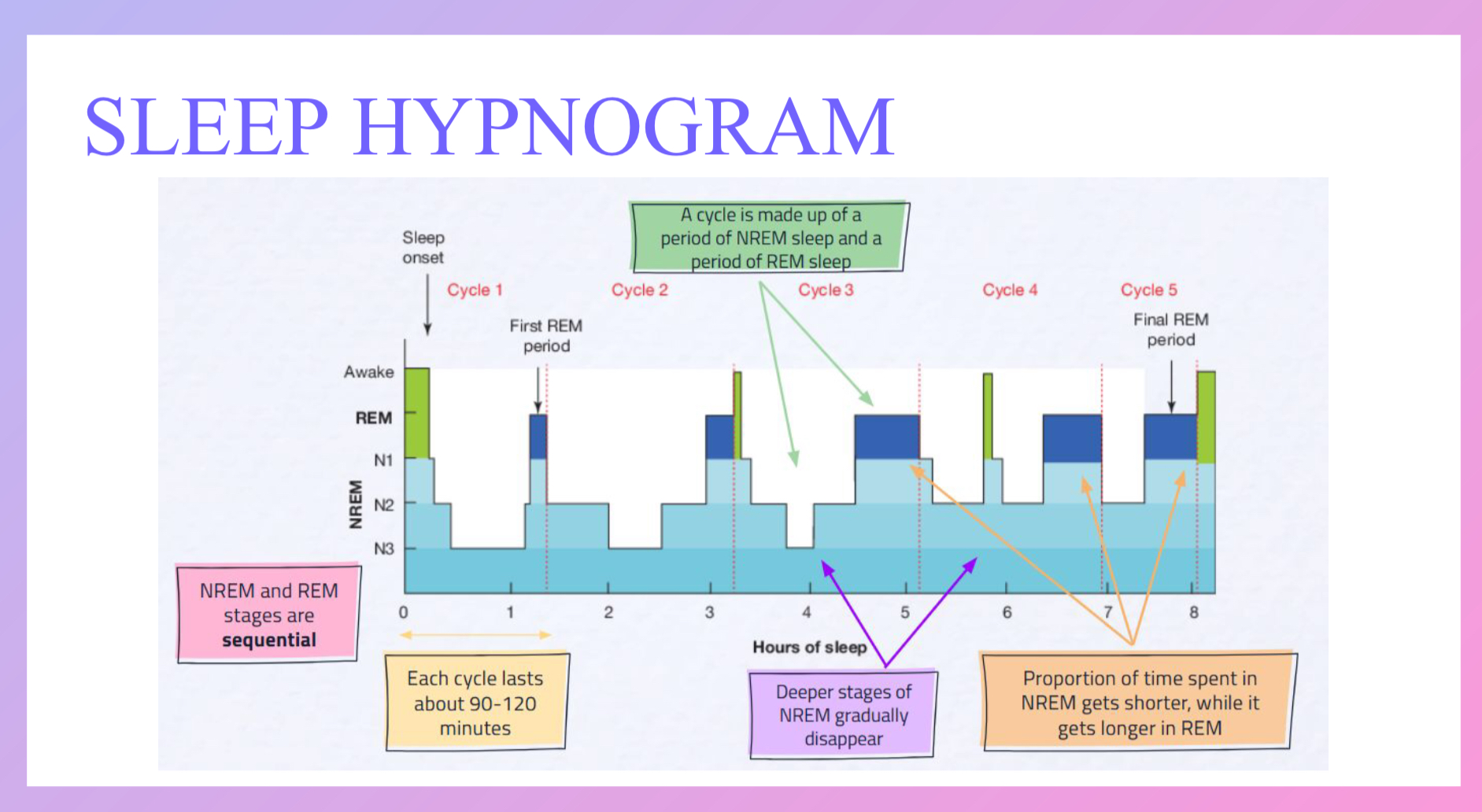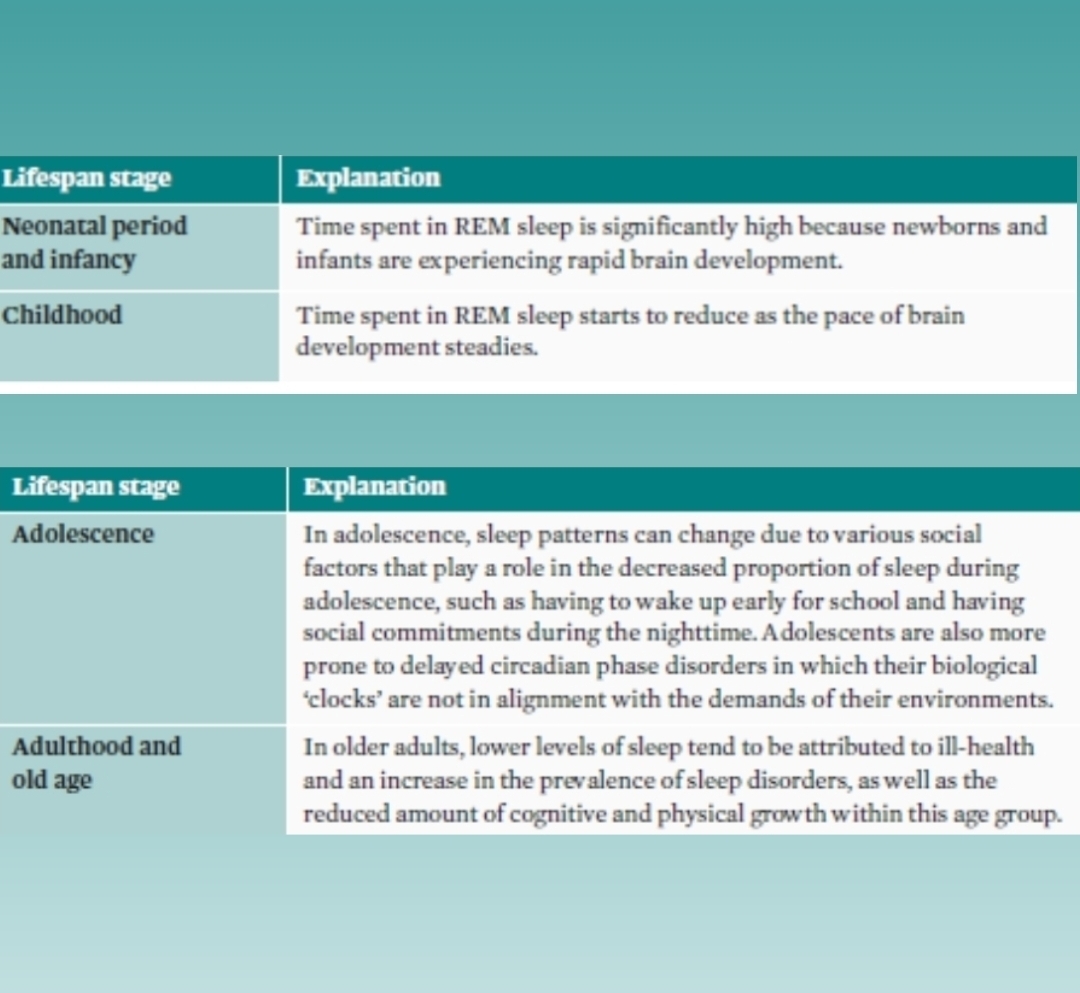sleep
1/96
There's no tags or description
Looks like no tags are added yet.
Name | Mastery | Learn | Test | Matching | Spaced |
|---|
No study sessions yet.
97 Terms
Consciousness
Awareness of internal or external stimuli
Normal waking consciousness
Being awake and aware of internal and external stimuli
Altered states of consciousness
Lack of awareness of internal and external stimuli
Types of altered states of consciousness
Naturally occurring and induced
Naturally occurring altered state of consciousness
Normal part of everyday life, does not require aids (sleep)
Induced altered state of consciousness
Intentionally brought on by some kind of aid (alcohol)
Sleep
Typically naturally occurring altered state of consciousness that occurs regularly
How is sleep characterised
By partial of total suspension of conscious awareness
Sleep as a psychological construct
Concepts, descriptions, or explanatory models that are constructed to describe specific psychological activity or a pattern of associated activities or processes
NREM
Non rapid eye movement sleep
REM
Rapid eye movement sleep
Sleep cycles
Sleep occurs in cycles that last approx. 90-120 mins
What are the components of a sleep cycle
NREM 1, NREM 2, NREM 3, REM
Duration of sleep
8 hours, 4-5 cycles
NREM stage 1
Falling/light sleep
Decreased heart rate, breathing rate, body temp, and muscle tension
Slow rolling eye movements
Involuntary muscle twitches (hyping jerks)
Low arousal threshold (easy to wake)
Slow down of brain waves
4-5% total sleep time
NREM stage 2
Moderate sleep
Decreased heart rate, breathing rate, body temp, and muscle tension
No eye movement
Middle arousal threshold (still easy to wake)
Further slow down of brain waves
10-25 min duration in first sleep cycle, duration increase throughout the night
NREM stage 3
Deep sleep
Lowest level of heart rate and breathing rate, muscles are completely relaxed
No eye movement
High arousal threshold (hard to wake)
Largest and slowest brain waves
Longest in early cycles, duration decreases throughout the night
REM characteristics
Rapid eye movements
20-25% of total sleep time
Periods of rem lengthen and become closer together throughout the night
Brain is very active
Heart rate is fast and irregular, blood pressure rises, breathing is shallow and fast, and body is paralysed
Sleep hypnotism characteristics
NREM and REM stages are sequential
Each cycle is 0-120 mins
Deeper stages of NREM disappear gradually
Duration in NREM decreases while duration in REM increases
Each cycle is made of a periods of NREM and REM

Subjective data
Based on personal opinion, interpretation, POV, or judgement
Objective data
Observable, measurable, and verifiable
Quantitative data
Numerical info on the quantity of what is being studied
Qualitative data
Non numerical info on the qualities of a participants experience of whats being studied
EEG
Detects, amplifies, and records electrical activity of the brain
Objective method
Brain waves
Spontaneous, rhythmic electrical impulses that come from diff brain areas
Beta waves
Alertness, concentration, thinking
High frequency
Low amplitude
Alpha waves
Meditation, creativity, relaxation
High frequency
Low amplitude
Theta waves
Visualisation, trance, dreaming
Med frequency
Med-high amplitude
Delta waves
Deep sleep, transcendence, restoration
Low frequency
High amplitude
EMG
Detects, amplifies, and records activity of muscles
Higher muscle activity and tone = more alert
Objective method
EOG
Detect, amplifies, and records electrical activity in eye muscles that control eye movements
Objective method
Sleep diaries
Self recorded and reported log of sleep and waking time over a period of time
Subjective method
Video monitoring
Observing sleep through cameras to monitor and recording externally observable physiological responses in real time over a prolonged period
Subjective method
Biological rhythms
Naturally occurring cycle of physiological, psychological, or behavioural changes
Biological clock
Innate timing mechanism that regulates the cycle of a biological rhythm
Ultradian rhythm
Physiological, psychological, or behavioural changed that occur as part of a cycle shorter than 24 hrs (heartbeat)
Circadian rhythm
Physiological, psychological and behavioural changes that occur as part of cycles with a duration of approx. 24 hrs
Endogenous
Originates within an organism
Exogenous
Originates outside an organism
Human sleep-wake cycle
24 hr cycle of being asleep and awake
Responsible for body clock
Naturally occurring
Self regulated by suprachiasmatic nucleus
Endogenous
Suprachiasmatic nucleus
Regulates timing and activity of sleep-wake cycle
Adjusts sleep-wake cycle in response to light and darkness
Keeps cycle in sync with the 24hr day and night cycle
Receives info from eyes and signals to pineal gland to modify melatonin release
Melatonin
Released by the pineal gland
Influences alertness and drowsiness
High melatonin = greater drowsiness, less alertness
Impact of light
Light enters eyes, eyes send info to suprachiasmatic nucleus
Suprachiasmatic nucleus regulates release of melatonin
Increase in melatonin results in sleepiness
Neonatal period
1-15 days
Infancy
3-24 months
Childhood
2-14 years
Adolescence
14-18 years
Young adulthood
18-30 years
Middle adulthood
30-75 years
Old age
75+ years
Neonatal period characteristics
16hr sleep
50% NREM
50% REM
Infancy characteristics
13.5 hr sleep
65% NREM
35% REM
Childhood characteristics
11 hr sleep
80% NREM
20% REM
Adolescence characteristics
9 hr sleep
80% NREM
20% REM
1-2 hr delay in sleep onset
Young adulthood characteristics
7.75 hr sleep
80% NREM
20% REM
Middle adulthood characteristics
7-8 hr sleep
80% NREM
20% REM
Old age characteristics
6 hr sleep
80% NREM
20% REM
Advanced sleep onset
Sleep duration…
…decreases as individuals age
NREM/REM proportion
REM decreses significantly in first 2 yrs of life
NREM decreases steadily
Awakenings during sleep…
…increase as individuals age
Sleep onset
Different ages result in differences in sleep onset time and duration
Why do characteristics of sleep alter as individuals age?
Sleep changes due to physical and cognitive needs
REM is important for brain and cognitive development
NREM is important for physiological rest and development

Sleep disturbance
Any sleep related issue that interupts an individuals normal sleep-wake cycle
Sleep disorder
A sleep disturbance that is persistent and regularly disrupts sleep, causing distress in important areas of everyday life
Primary sleep disorder
Main cause of the sleep disturbance
Secondary sleep disorder
The result of another condition or use of a substance
Sleep deprivation
A state caused by inadequate quality or quantity of sleep
Partial sleep deprivation
Having sleep quality or quantity of sleep than what is normally required
Total sleep deprivation
No sleep at all over a 24 hr period
Partial sleep deprivation impact on affective functioning
Anxiety
Amplified emotional responses
Mood swings
Increased irritability
Easily annoyed
Partial sleep deprivation impact on behavioural functioning
Microsleeps
Excessive sleepiness
Sleep inertia
Slower reaction time
Dizziness
Slurred speech
Shaking hands
Sleep inertia
Confusion when woken up
Partial sleep deprivation impact on cognitive functioning
Confusion
Inability to think clearly
Thoughts that do not make sense
Difficulty retrieving or forming memories
Blood alcohol concentration
Measure of how much alcohol is in an individuals bloodstream
Alcohol
Depressant drug that slows the nervous system, decreases alertness, reflexes, and concentration
17 hrs of sleep deprivation is equivalent to a BAC of…
0.05%
24 hrs of sleep deprivation is equivalent to a BAC of…
0.10%
Alcohol impact on affective functioning
Feelings of happiness, excitement, anger, or sadness
Long term effects lead to dulling effects and depression
Difficulty judging emotions
Amplified emotional responses
Alcohol impact on cognitive functioning
Slower mental processes
Decreased ability to reason and problem solve
Reduced ability to make decisions quickly and effectively
Cognitive distortions
Circadian rhythm sleep disorders
Sleep disorders that are primarily due to a mismatch between a persons sleep-wake pattern and their desired pattern
Circadian rhythm sleep disorders may be cause by…
Mismatch between sleep-wake cycle and day-night cycle of physical environment
Mismatch between sleep-wake cycle and the sleep-wake schedule required by school or work
Delayed sleep phase syndrome
Major sleep ep occurs later than usual, sleep-wake cycle is delayed
Advanced sleep phase disorder
Major sleep ep occurs earlier than usual, sleep-wake cycle is advanced
Shift work
Occupation leads individuals to work at unusual times, resulting in them sleeping at unusual times
Bright light therapy
Used to adjust a persons sleep-wake cycle to a desired schedule through exposure to high intensity light sources
Bright light therapy factors
Must be at an appropriate time
Must be the appropriate amount of light
Must be safe
How can bright light therapy aid DSPS
Light exposure in the morning acts as external cue to SCN to promote wakefulness by signalling the release cortisol. This helps SCN to send signals for melatonin release at an earlier time.
How can bright light therapy aid ASPS
Light exposure in the evening acts as external cue to SCN to promote wakefulness by signalling the release cortisol. This helps SCN to send signals for melatonin release at a later time.
How can bright light therapy aid in shift work
Light exposure before the beginningof a shift acts as external cue to SCN to promote wakefulness by signalling the release cortisol. This helps SCN to send signals for melatonin release at a later time when the person is not required to work.
Sleep hygiene
The habits that promote an individuals sleep patterns. Good sleep hygiene improves sleep quality and quantity.
Zeitgebers
External cues from the environment that influence the circadian rhythm. Regulates sleep-wake cycle and promotes sleepiness and wakefulness
Zeitgebers - blue light
Light that is emitted naturally and artificially. Promotes wakefulness by signalling to the suprachiasmatic nucleus to cease melatonin production
Zeitgebers - daylight
Light individuals are exposed to during the day. Promotes wakefulness by signalling to the suprachiasmatic nucleus to cease melatonin production
Zeitgebers - temperature
The degree of external heat in the environment. Extreme temps are not good for quality or quantity of sleep
Zeitgebers - eating and drinking
What individuals consume influences quality and quantity of sleep. Eating too close tobsleep time negatively impacts sleep as the digestive system is stimulated. Going to sleep too hungry or full can negatively impact sleep quality and quantity
Zeitgebers - eating and drinking - caffeine
Increases activity of nervous system
Blocks sleep promoting neurotransmitters
Promotes wakefulness
Zeitgebers - eating and drinking - high sugar and fat foods
Negatively impacts sleep quality and quantity